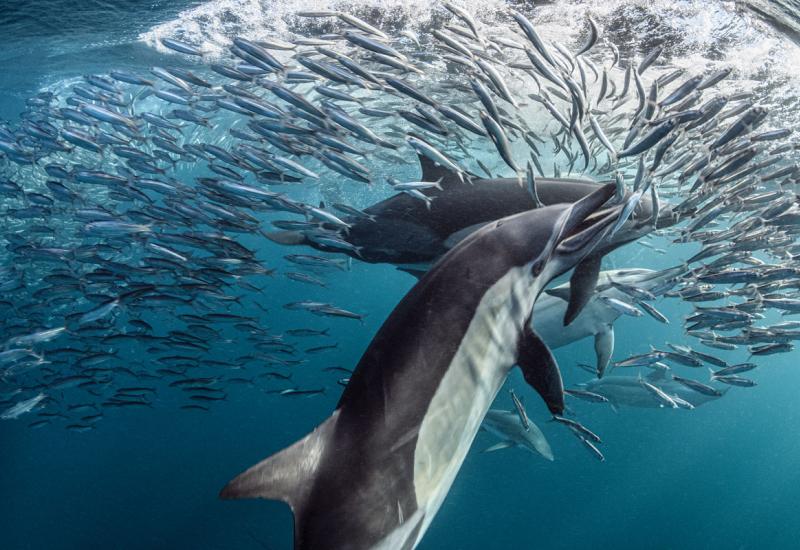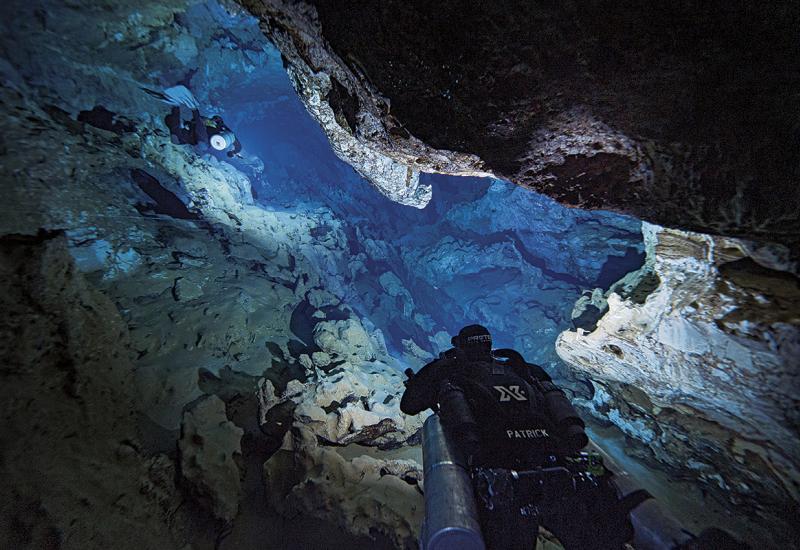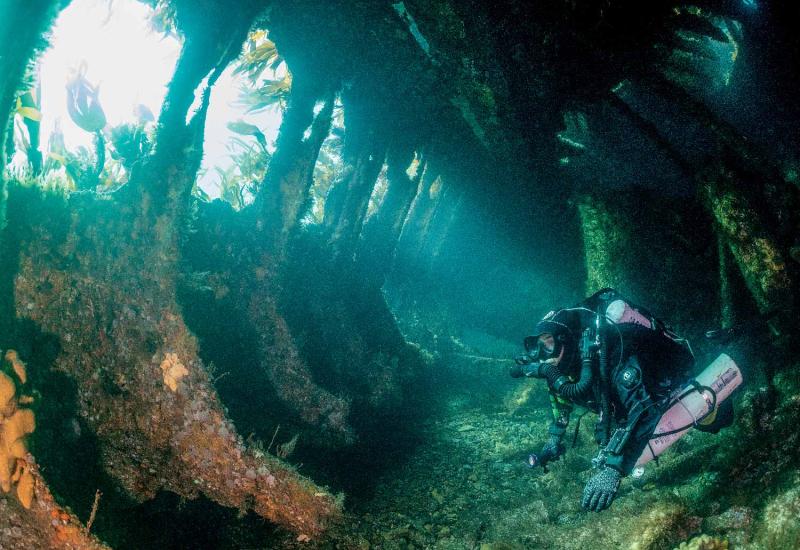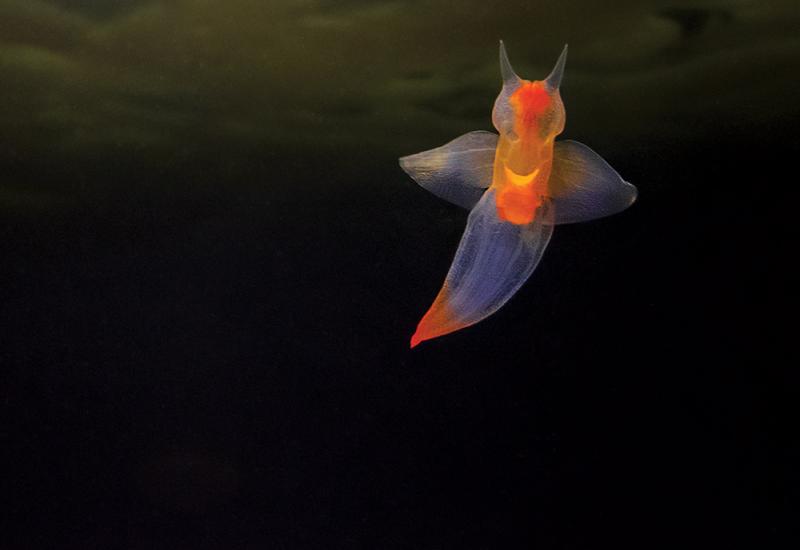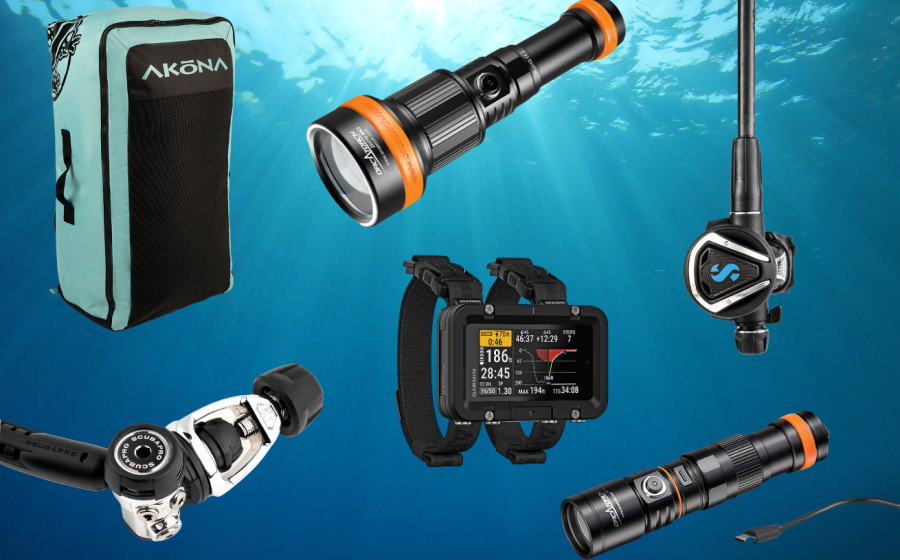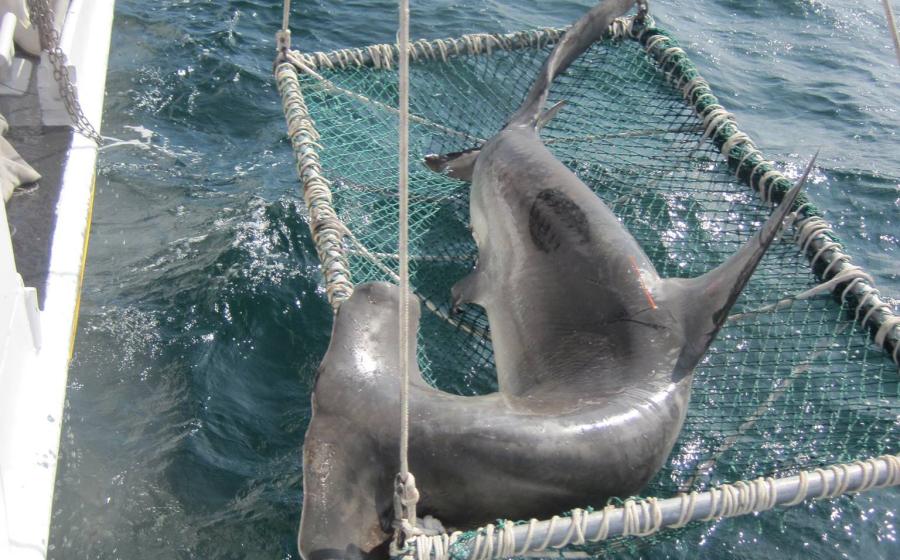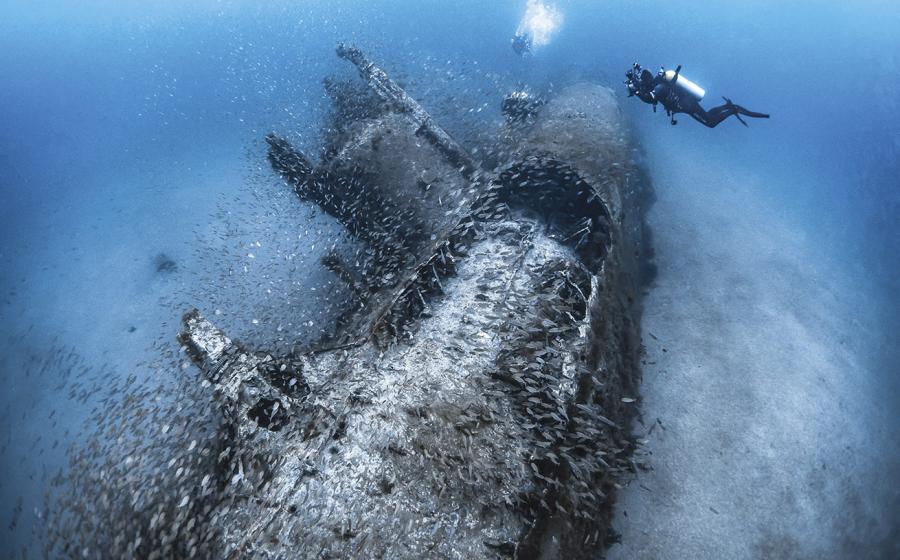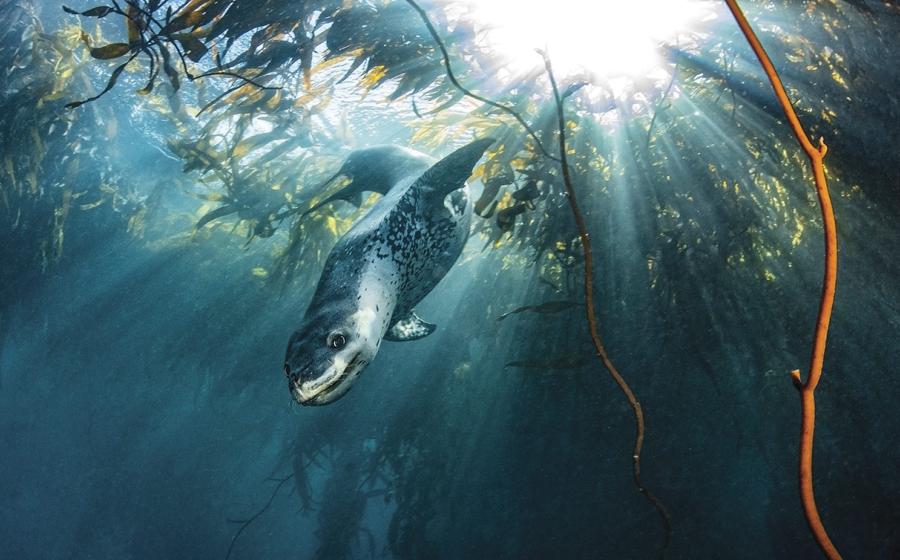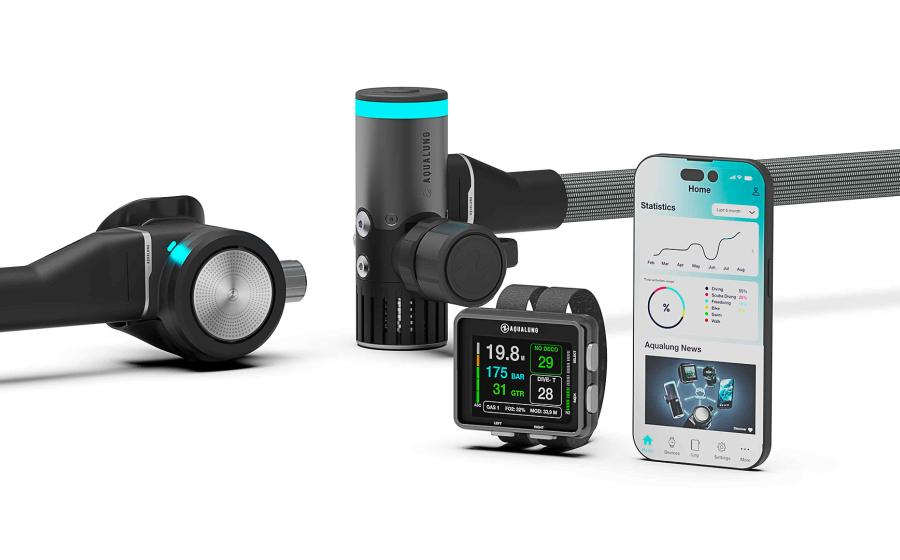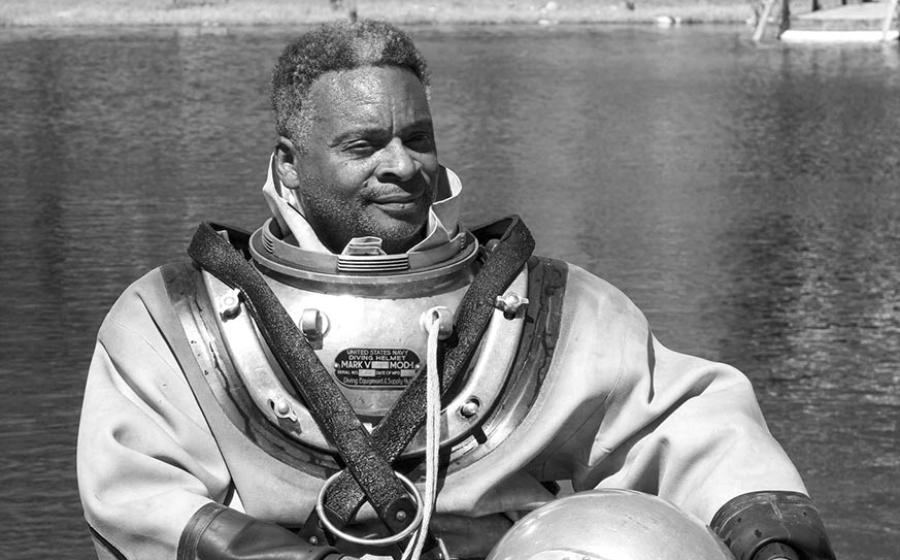Advanced Adventure: Fjord Diving in British Columbia
Lords of the Fjords
Past the century mark now, and still we drop. Time slows but my heart rate quickens as we leave light far behind. Into the void, past pale, twisted, unrecognizable shapes. The darkness is visceral. I’m breathing in a blackness that seeps through me, painting even the insides of my eyelids black. One hundred and fifty feet, then 160. Finally, a burst of red, then another, and another deeper still. Gorgonian sea fans light up the night like flaming cotton candy. Extending from the wall in sprays and arcs, they are exquisite, and seemingly out of place in this cold, harsh nothingness. Also clinging to the vertical face are cloud sponges, huge masses of spiked, trumpet-shaped tubes glowing ghostly white and gold. My unfettered imagination sees gigantic melting candles in a macabre dungeon, or pearly flowstone formations oozing through a subterranean chamber. Spindly-legged crabs clamber about this convoluted kingdom where rockfish stare suspiciously at us and something else moves wraithlike along the wall. The scenery is mesmerizing, alien.
Then my computer’s depth alarm sounds, loudly breaking the spell. I had programmed it for a wake-up call at 180 feet. The pull to keep descending is seductive, but more beeping and blinking jangles my nerves and reminds me our time is up. We signal each other game over, and begin a long climb back to the surface.
Twenty minutes of deco later, we’re welcomed back by Kal Helyar, master and commander aboard Devilfish. “And how was it? Did you make it to the sea fans?”
Waddling back to the bench, I plonk down and spit out my reg, grateful to take a load off.
Haltingly, as if I’m struggling to recall the power of speech, I answer, “Awe ... some. Yes.”
“Scary and beautiful,” my wife, Melissa, says. “And strange,” I add. I breathe deeply, inhaling the pure scent of rain on a brisk February wind, seasoned by the tang of salt air. Helyar gets some hot chocolate into us, and then a veritable novel comes pouring out, beginning and ending with “amazing.”
Deep in the Emerald Gloom
We’ve come to Canada’s rugged Sunshine Coast northwest of Vancouver for a midwinter escape from the rain and cold, and to push ourselves with challenging dives like the aforementioned descent into the Powerlines in Agamemnon Channel and — if the fates are kind and the tides align — Sechelt Rapids in Skookumchuck Narrows. This is fjord diving. There’s no better place to do it, and no one better than Helyar to point you in the right direction, which usually is down. He and his wife, Ann Beardsell, own Porpoise Bay Charters and Strong Water Retreat near the tiny town of Egmont on the Sechelt Peninsula. Having dived BC’s inland waters for 25 years, they know the current-swept passes and deep reaches intimately.
Over a hearty breakfast we reminisce on yesterday’s out-of-body experience and waves of terror among the eerie sponges, and how fear gave way to fascination. Helyar smiles and says, “We’ll get you back there for another splash, but today let’s do the Chaud and then shoot the Skook. Decent slack in the afternoon, so we’ll go deep first, then fast!”
The Chaud, officially the HMCS Chaudiere, is a 366-foot-long Canadian destroyer escort and a survivor of the post-WWII nuclear blast tests in Bikini. It’s currently stationed below the waves, precariously perched on a steep slope off Kunechin Point, where its bow hangs off a ledge at 140 feet.
I first dived the Chaud just a month after it was intentionally sunk in 1992 — 23 years later, it looks better than ever as we follow the ship’s starboard flank downward from 60 to 100 feet. The water temp is 45, and viz about the same. Orange and white plumose anemones sprout a foot tall from railings. Smaller anemones and glassy tunicates coat its svelte sides, shimmering and winking back the light from our roving LED cannons. Perch flitter out of our way; lingcod remain in loiter mode, unfazed by our intrusion.
We bank hard left at midships to descend another atmosphere in the superstructure’s oppressive shadow. My guts lurch, and equilibrium goes out the window. My internal gyroscope temporarily scrambles, knocked off its axis. Lying at 90 degrees on its port side, deep in the emerald gloom, the Chaudiere can be disorienting. I pull out of my off-kilter swan dive at 135 feet, just above the mud bottom, shake my head to clear the cobwebs and stare upward right into doom: the massive twin barrels of the front turret guns, with me directly in their sights. Daunting and dramatic, it makes a killer shot. But it’s not easy to work both brain and camera down here, and all too soon my 28 percent nitrox mix is running low. If only we were on rebreathers.
Helyar and Beardsell host advanced divers of all stripes — trimix techies, power lifters lugging chandeliers of stage bottles, scientists doing three-hour, 300-foot submersions to study fragile deepwater sponges and gorgonians — including many keen to drift the Skook, our next stop.
Shooting the Skook
Under a leaky, leaden sky, we wind our way back up Sechelt Inlet. We’re not in any particular hurry because we have to wait for the tide. Grateful for the boat’s covered (and heated) cabin, we watch ribbons of fog weave through moss-bearded cedar and fir. A bald eagle materializes out of a low bank of cloud just above the dead-calm black water. “No real movement down here right now, but it will still be cranking up at the rapids. Time to relax, enjoy the scenery,” our captain advises. It is stunning country, mountainous and wild, like the backdrop for a Viking movie.
Sechelt Rapids is also known as Skookumchuck Narrows, or the Skook for short. In the First Nations’ language, skookum means strong.
Famous among daredevil kayakers, infamous among boaters and alluring to at least some divers, these are strong waters and — make no mistake — potentially dangerous. A Coast Guard boat flipped here in 2012, killing two people. Divers also have met their end here. Standing waves, whirlpools, downdrafts, layers of water racing in opposite directions — the current can scream up to 16 knots here, making these the fastest navigable waters in North America.
To dive the Skook safely and enjoyably, lots of things have to come together. Skill, experience and fitness are mandatory, as is a live-boat pickup. A good slack window really helps too. Winter’s smaller tidal exchanges are generally best in this regard, giving you longer slack time between ebb and flood tides, when water movement is at a minimum. Slack might be five minutes or 20, and some days it’s zero, switching directions without a lull. One can usually go with the flow for a few moments before and after the change, but you absolutely need to know when it’s time to end the dive.
Helyar looks at his watch, consults a well-thumbed book with current tables and then throws an oyster shell overboard. We watch it sink, fluttering back and forth, but with an obvious sideways trajectory to its descent. The ebb current is still too strong along Observation Wall, probably the most popular Skook site within the Narrows. Melissa and I are ready to go, but the old shell trick tells us to wait.
A few minutes later we’re given the green light. Into the drink, with no dallying at the sur- face. We bomb straight down to 50 feet and press tight up against the wall. There’s just a hint of the dying ebb. With military precision, Helyar has dropped us in exactly the right place at exactly the right time. We smile, thanking the oyster that gave its life for our safety and enjoyment.
And so begins our swim through a kaleidoscope. It’s a living, tentacled mosaic of thousands of anemones in red, white, pink, yellow and green, stretching left and right, up and down. Sponges, urchins and sea stars compete for real estate. Life is stacked upon life, a common theme at BC’s best dive sites. I see kelp greenlings and rockfish nonchalantly dancing about in the water column — it will be a different story in half an hour when they have to hunker down like sponges once the maelstrom returns. We spy gobies and sculpins, nudibranchs and crabs, and a magnificent red Irish lord with bulging eyes speckled like a starlit sky. Twenty-five minutes drift by peacefully before someone grabs my fins and turns me around. A bit perturbed that my wife would play such a prank, I look back. But she’s beside me. An invisible, irresistible force begins pushing on my forehead, driving me back. Melissa makes an elaborate signal, two hands circling each other, spinning wildly, and then motions as if she’s sweeping plankton through the water. Impressive, but huh?
I realize I’m kicking now and just barely holding position along the wall. A kelp greenling zings past me to wedge itself snugly into a rock crevice packed with sponges and purple sea stars, their five arms gripping tight. The current has come calling. Our time is up.
Back on board, Helyar’s grin matches ours. “And how was it?” Melissa’s answer says it all: “Can we do that again?”
I blurt out, “And Powerlines too?”
“Sounds like a plan for tomorrow,” Helyar says. “Forecast is even calling for sun.”
Sun on the Sunshine Coast? Maybe, but I look forward to leaving the light far, far behind, deep beneath the sea.
WHAT IT TAKES
Part of being an advanced diver is being able to avoid damaging marine life. The fragile, delicate nature of many of the creatures found in this area makes operators hesitant to take careless divers to some of these sites — good buoyancy and spatial awareness are key. There’s plenty of current and depth in these inlets; the author cannot stress strongly enough the wisdom in diving with those who know these skookum waters. (Though this article focuses on advanced sites, the region also has many wonderful sites for novices and intermediates.)
NEED TO KNOW
When to Go British Columbia’s Sunshine Coast offers year-round diving. In general, fall and winter months have the best visibility (50 to 150 feet). Plankton blooms (more common in spring and summer) can reduce visibility, but it’s often still clear below a green surface layer. Topside weather runs the full gamut from cool and rainy to warm and sunny.
Dive Conditions The fjords are well-protected from open-ocean storms and swells. Water temperatures hover around 45 degrees at depth. Drysuits are a must, especially for wintertime multiday diving trips and the long bottom times often realized in technical diving.
Operator Porpoise Bay Charters (porpoisebaycharters.com) has unmatched expertise in these waters. It caters to divers of all skill levels, rec and tec, and is well-equipped to facilitate advanced diving. Cozy waterfront accommodations and savory home-cooked meals at Strong Water Retreat will satisfy all your needs above the waterline.
Price Tag Complete packages (diving, accommodations and meals) cost $250 Canadian per day.
FOUR TIPS FOR SHOOTING THE FJORDS
1 Be wary of the unique, rare and very fragile marine life at sites like Powerlines. Cloud sponges and gorgonians are easily killed by careless kicks, grasping hands, flopping gauges and flailing gear. Respect and protect to ensure these deepwater denizens will be there for the next shooter.
2 Balance your rig with foam floats or buoyant strobe arms. At sites subject to current, you’ll appreciate a neutrally balanced rig you can shoot with one hand — your other might be needed to hold onto bare rock or dead barnacles to keep you in position.
3 On the Chaudiere, keep your shot list simple and do your homework. Disorientation and frustration can snowball into trouble. Study a drawing of the ship. Take a slate with you on which you’ve sketched the wreck, your intended path, photo targets, and depths and locations of the fixed buoy lines.
4 Know your photo gear well. Practice on easier dives (or in a dark closet while wearing your gloves) so knowing which buttons to push becomes second nature. There’s no time to waste fiddling around when the slack-tide window is closing fast.
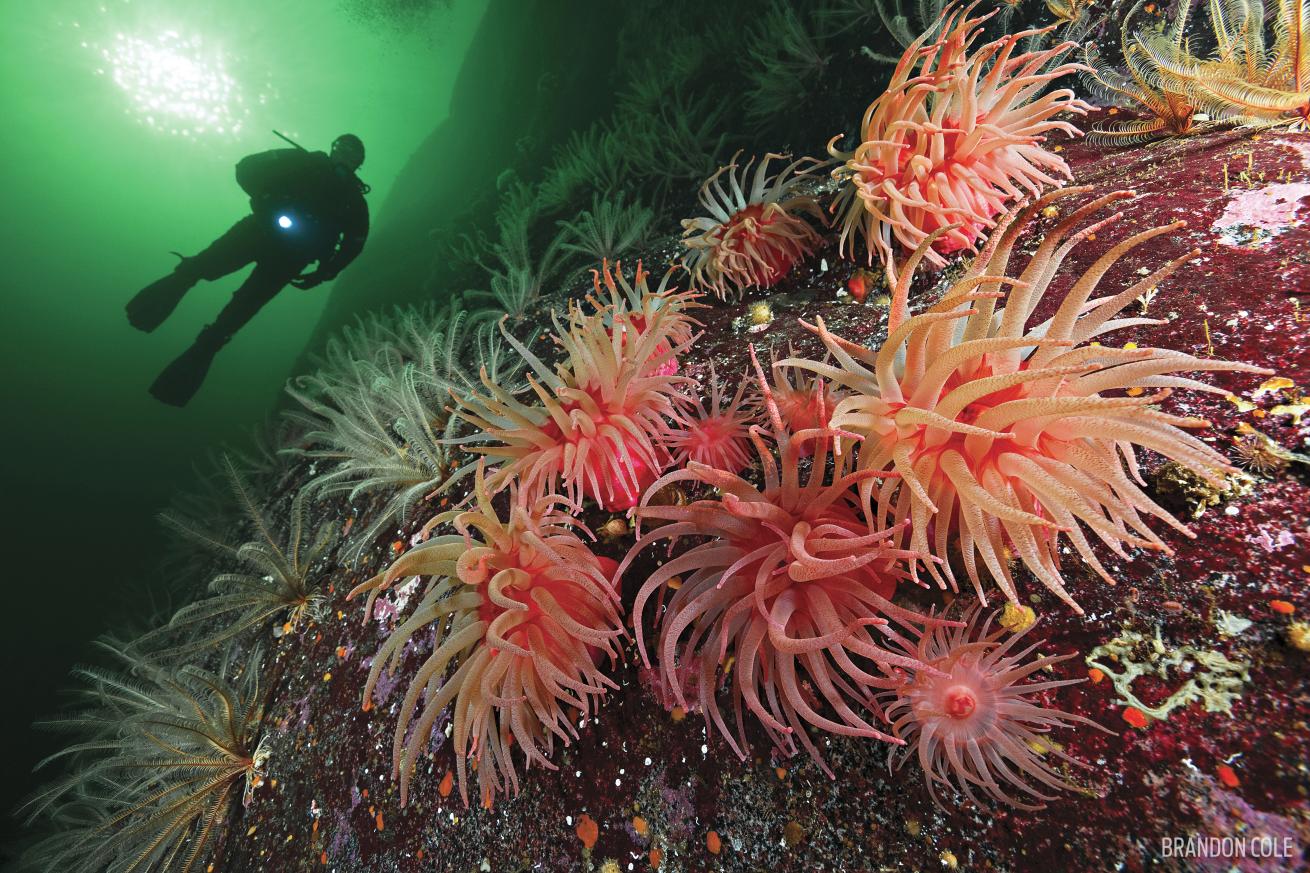
Brandon ColeCrimson sea anemones and feather stars contrast spectacularly with the emerald waters in British Columbia.
Lords of the Fjords
Past the century mark now, and still we drop. Time slows but my heart rate quickens as we leave light far behind. Into the void, past pale, twisted, unrecognizable shapes. The darkness is visceral. I’m breathing in a blackness that seeps through me, painting even the insides of my eyelids black. One hundred and fifty feet, then 160. Finally, a burst of red, then another, and another deeper still. Gorgonian sea fans light up the night like flaming cotton candy. Extending from the wall in sprays and arcs, they are exquisite, and seemingly out of place in this cold, harsh nothingness. Also clinging to the vertical face are cloud sponges, huge masses of spiked, trumpet-shaped tubes glowing ghostly white and gold. My unfettered imagination sees gigantic melting candles in a macabre dungeon, or pearly flowstone formations oozing through a subterranean chamber. Spindly-legged crabs clamber about this convoluted kingdom where rockfish stare suspiciously at us and something else moves wraithlike along the wall. The scenery is mesmerizing, alien.
Then my computer’s depth alarm sounds, loudly breaking the spell. I had programmed it for a wake-up call at 180 feet. The pull to keep descending is seductive, but more beeping and blinking jangles my nerves and reminds me our time is up. We signal each other game over, and begin a long climb back to the surface.
Twenty minutes of deco later, we’re welcomed back by Kal Helyar, master and commander aboard Devilfish. “And how was it? Did you make it to the sea fans?”
Waddling back to the bench, I plonk down and spit out my reg, grateful to take a load off.
Haltingly, as if I’m struggling to recall the power of speech, I answer, “Awe ... some. Yes.”
“Scary and beautiful,” my wife, Melissa, says. “And strange,” I add. I breathe deeply, inhaling the pure scent of rain on a brisk February wind, seasoned by the tang of salt air. Helyar gets some hot chocolate into us, and then a veritable novel comes pouring out, beginning and ending with “amazing.”
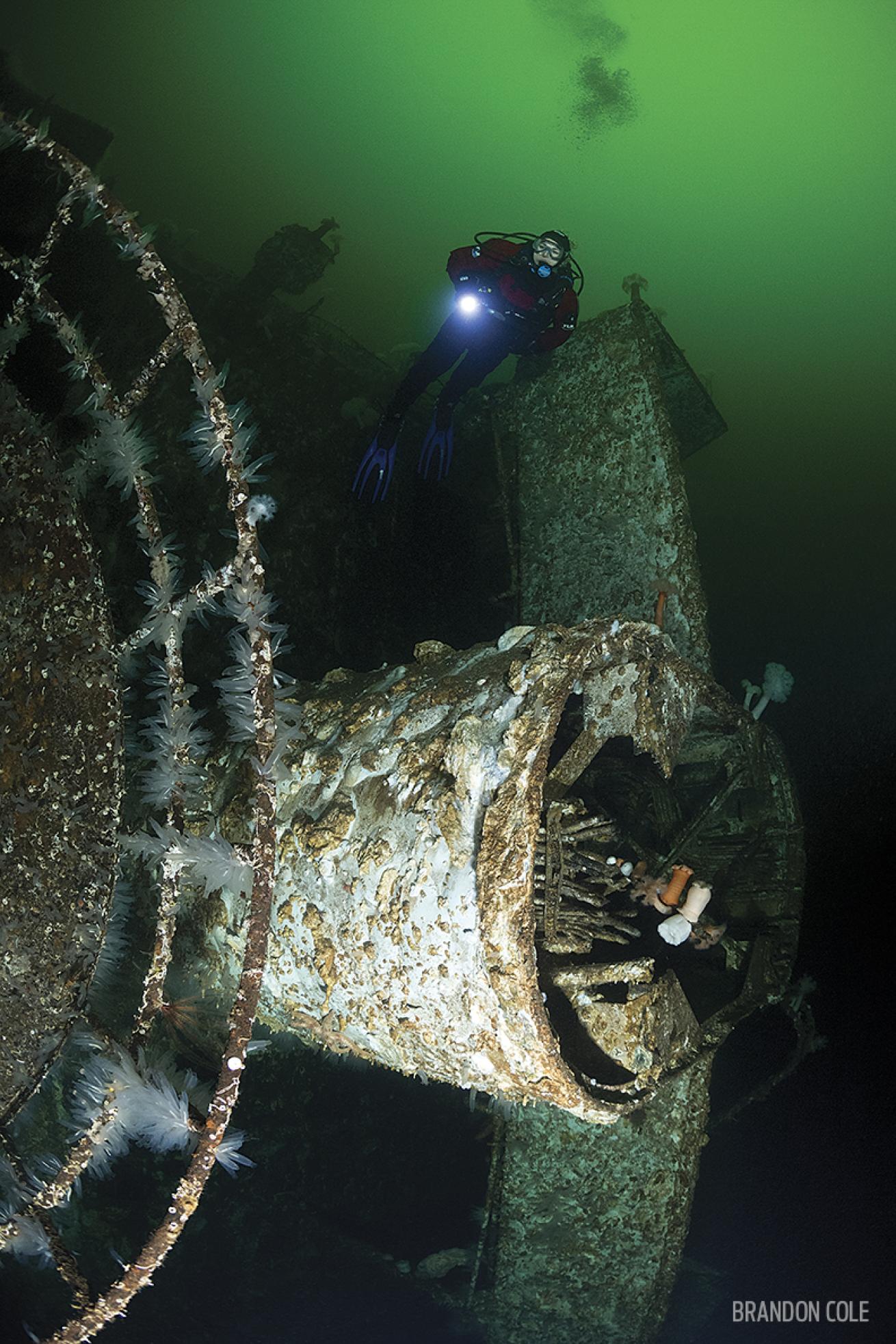
Brandon ColeDivers are dwarfed by massive barrels of the forward turret gun on the HMCS Chaudiere, a 366-foot long artificial reef which was once a Canadian warship. It was sunk in 1992 in Sechelt Inlet and is a popular advanced scuba dive, with depths between 60 and 140 feet. Much of the wreck is covered in giant plumose sea anemones (Metridium farcimen) and tunicates (Ciona savignyi).
Deep in the Emerald Gloom
We’ve come to Canada’s rugged Sunshine Coast northwest of Vancouver for a midwinter escape from the rain and cold, and to push ourselves with challenging dives like the aforementioned descent into the Powerlines in Agamemnon Channel and — if the fates are kind and the tides align — Sechelt Rapids in Skookumchuck Narrows. This is fjord diving. There’s no better place to do it, and no one better than Helyar to point you in the right direction, which usually is down. He and his wife, Ann Beardsell, own Porpoise Bay Charters and Strong Water Retreat near the tiny town of Egmont on the Sechelt Peninsula. Having dived BC’s inland waters for 25 years, they know the current-swept passes and deep reaches intimately.
Over a hearty breakfast we reminisce on yesterday’s out-of-body experience and waves of terror among the eerie sponges, and how fear gave way to fascination. Helyar smiles and says, “We’ll get you back there for another splash, but today let’s do the Chaud and then shoot the Skook. Decent slack in the afternoon, so we’ll go deep first, then fast!”
The Chaud, officially the HMCS Chaudiere, is a 366-foot-long Canadian destroyer escort and a survivor of the post-WWII nuclear blast tests in Bikini. It’s currently stationed below the waves, precariously perched on a steep slope off Kunechin Point, where its bow hangs off a ledge at 140 feet.
I first dived the Chaud just a month after it was intentionally sunk in 1992 — 23 years later, it looks better than ever as we follow the ship’s starboard flank downward from 60 to 100 feet. The water temp is 45, and viz about the same. Orange and white plumose anemones sprout a foot tall from railings. Smaller anemones and glassy tunicates coat its svelte sides, shimmering and winking back the light from our roving LED cannons. Perch flitter out of our way; lingcod remain in loiter mode, unfazed by our intrusion.
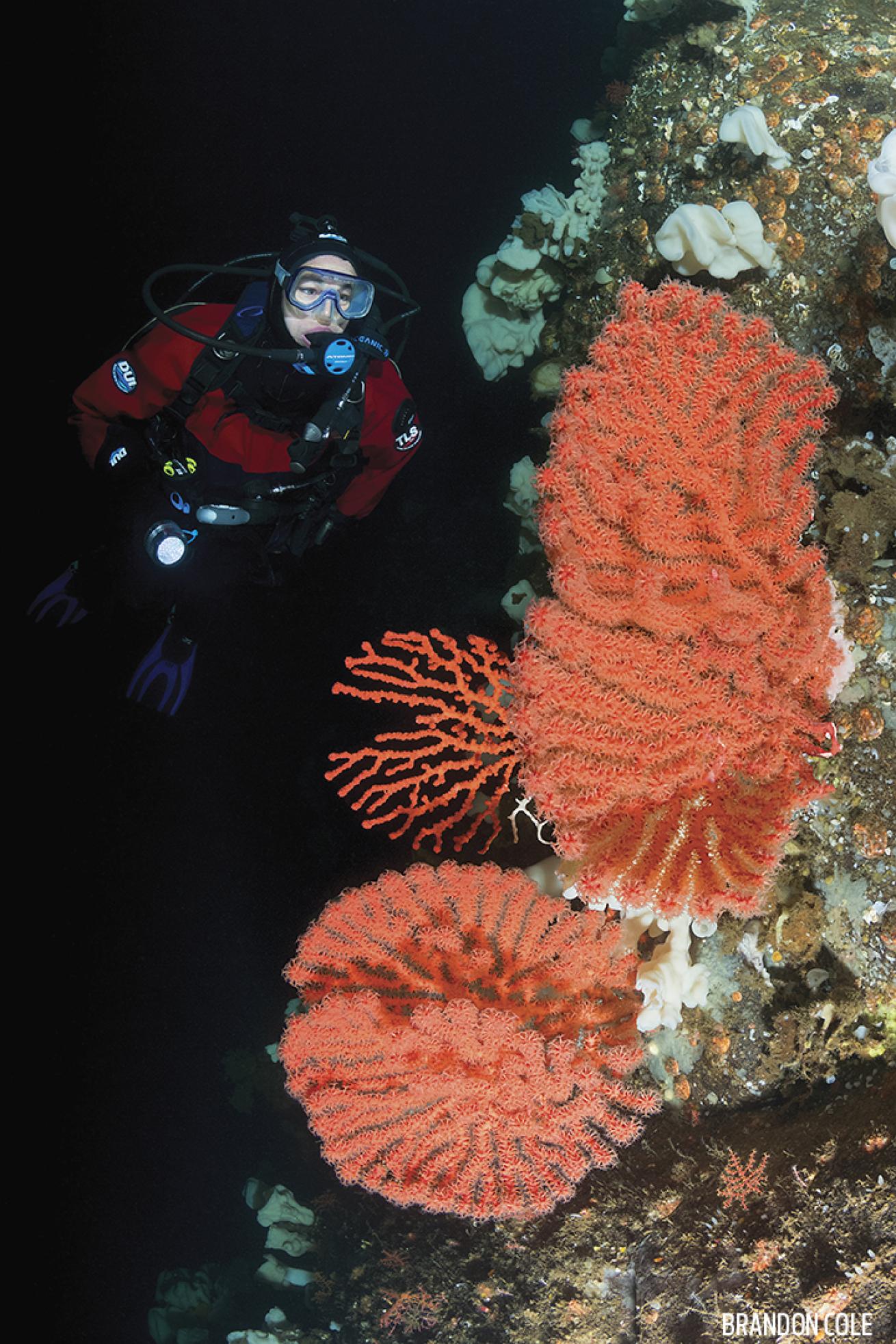
Brandon ColeFear becomes fascination for divers conquering the inland walls and insane currents of British Columbia.
We bank hard left at midships to descend another atmosphere in the superstructure’s oppressive shadow. My guts lurch, and equilibrium goes out the window. My internal gyroscope temporarily scrambles, knocked off its axis. Lying at 90 degrees on its port side, deep in the emerald gloom, the Chaudiere can be disorienting. I pull out of my off-kilter swan dive at 135 feet, just above the mud bottom, shake my head to clear the cobwebs and stare upward right into doom: the massive twin barrels of the front turret guns, with me directly in their sights. Daunting and dramatic, it makes a killer shot. But it’s not easy to work both brain and camera down here, and all too soon my 28 percent nitrox mix is running low. If only we were on rebreathers.
Helyar and Beardsell host advanced divers of all stripes — trimix techies, power lifters lugging chandeliers of stage bottles, scientists doing three-hour, 300-foot submersions to study fragile deepwater sponges and gorgonians — including many keen to drift the Skook, our next stop.
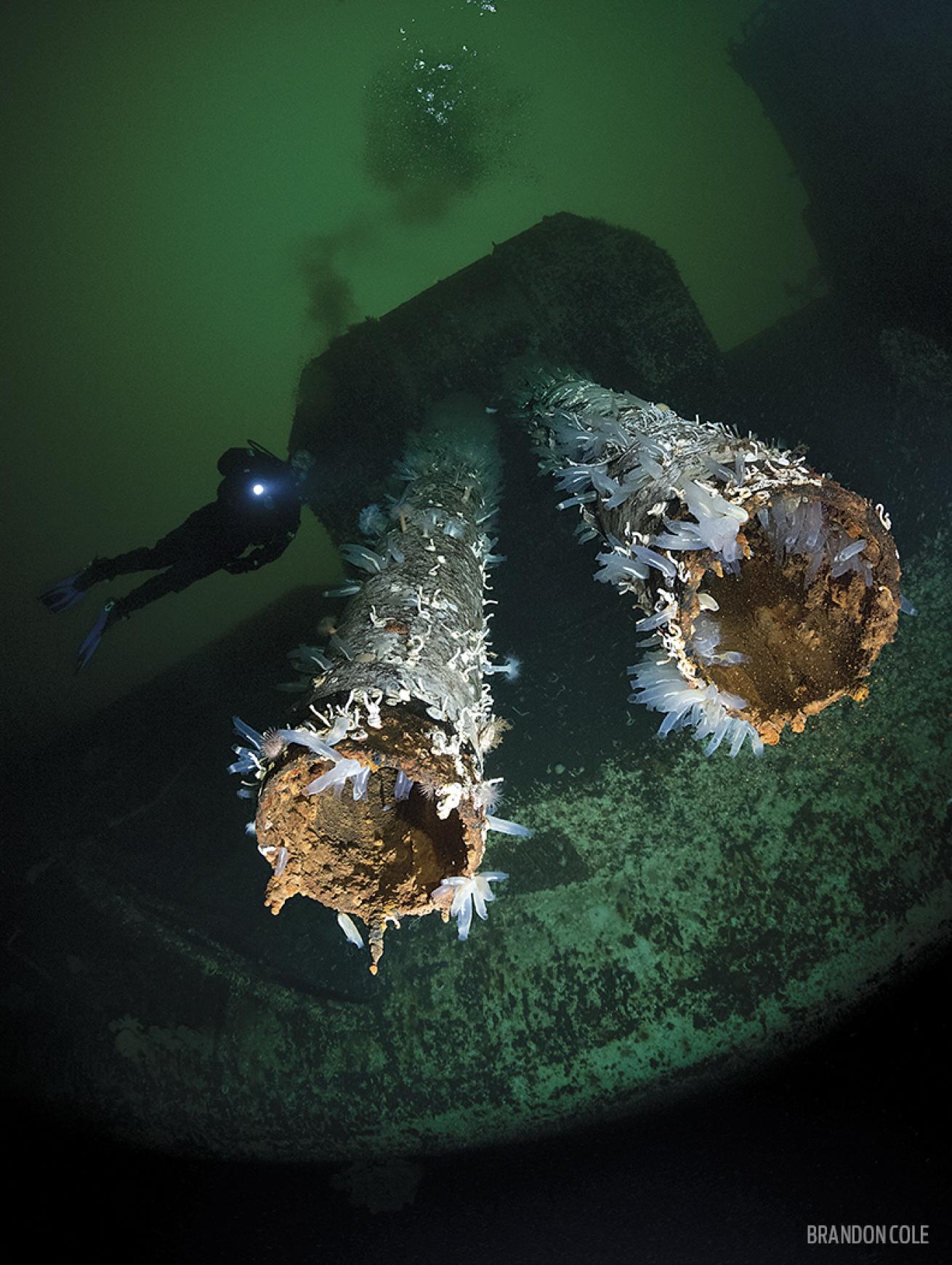
Brandon ColeThe Chaudiere, a 366-foot-long artificial reef sunk in 1992, is a popular advanced scuba dive.
Shooting the Skook
Under a leaky, leaden sky, we wind our way back up Sechelt Inlet. We’re not in any particular hurry because we have to wait for the tide. Grateful for the boat’s covered (and heated) cabin, we watch ribbons of fog weave through moss-bearded cedar and fir. A bald eagle materializes out of a low bank of cloud just above the dead-calm black water. “No real movement down here right now, but it will still be cranking up at the rapids. Time to relax, enjoy the scenery,” our captain advises. It is stunning country, mountainous and wild, like the backdrop for a Viking movie.
Sechelt Rapids is also known as Skookumchuck Narrows, or the Skook for short. In the First Nations’ language, skookum means strong.
Famous among daredevil kayakers, infamous among boaters and alluring to at least some divers, these are strong waters and — make no mistake — potentially dangerous. A Coast Guard boat flipped here in 2012, killing two people. Divers also have met their end here. Standing waves, whirlpools, downdrafts, layers of water racing in opposite directions — the current can scream up to 16 knots here, making these the fastest navigable waters in North America.
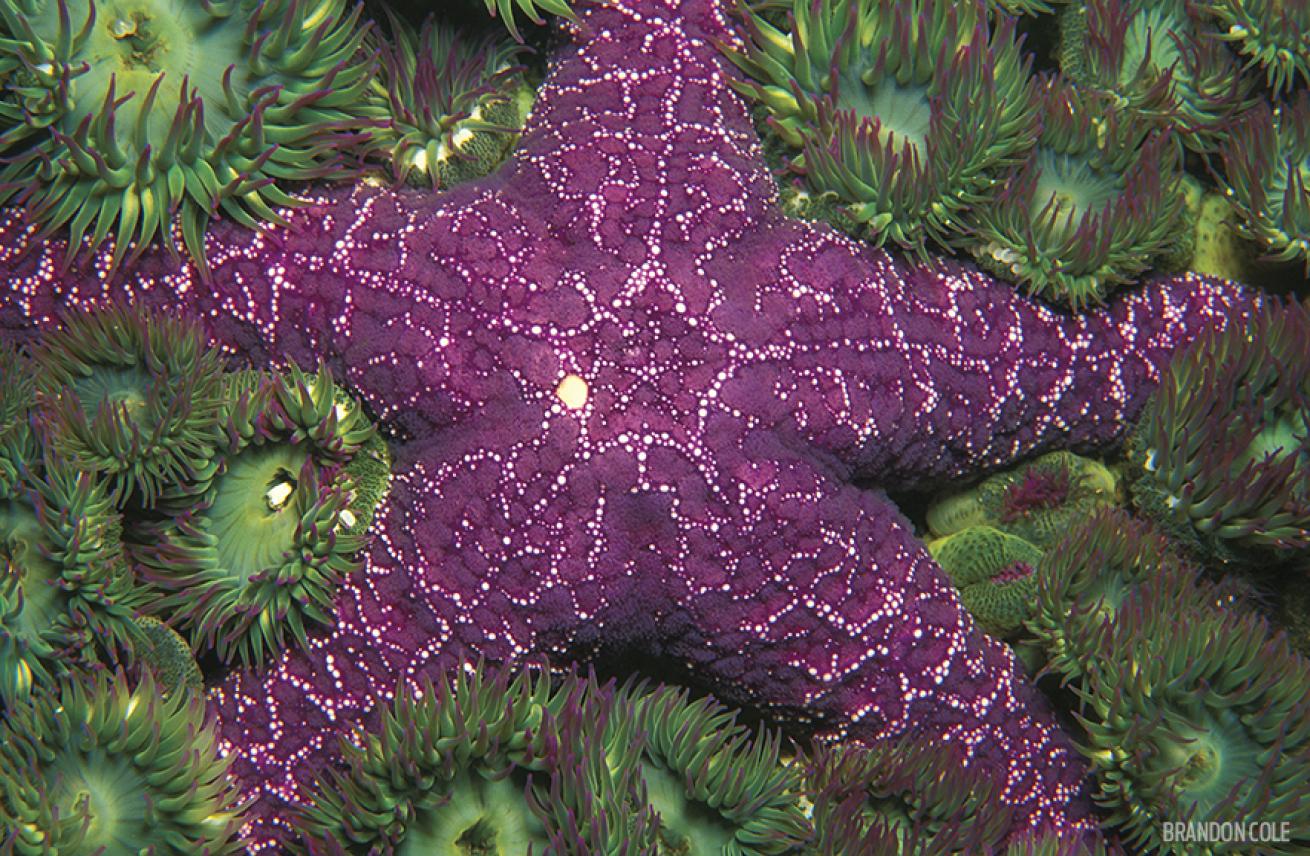
Brandon ColeBelow the waves off British Columbia's Sunshine coast divers can find sea stars.
To dive the Skook safely and enjoyably, lots of things have to come together. Skill, experience and fitness are mandatory, as is a live-boat pickup. A good slack window really helps too. Winter’s smaller tidal exchanges are generally best in this regard, giving you longer slack time between ebb and flood tides, when water movement is at a minimum. Slack might be five minutes or 20, and some days it’s zero, switching directions without a lull. One can usually go with the flow for a few moments before and after the change, but you absolutely need to know when it’s time to end the dive.
Helyar looks at his watch, consults a well-thumbed book with current tables and then throws an oyster shell overboard. We watch it sink, fluttering back and forth, but with an obvious sideways trajectory to its descent. The ebb current is still too strong along Observation Wall, probably the most popular Skook site within the Narrows. Melissa and I are ready to go, but the old shell trick tells us to wait.
A few minutes later we’re given the green light. Into the drink, with no dallying at the sur- face. We bomb straight down to 50 feet and press tight up against the wall. There’s just a hint of the dying ebb. With military precision, Helyar has dropped us in exactly the right place at exactly the right time. We smile, thanking the oyster that gave its life for our safety and enjoyment.
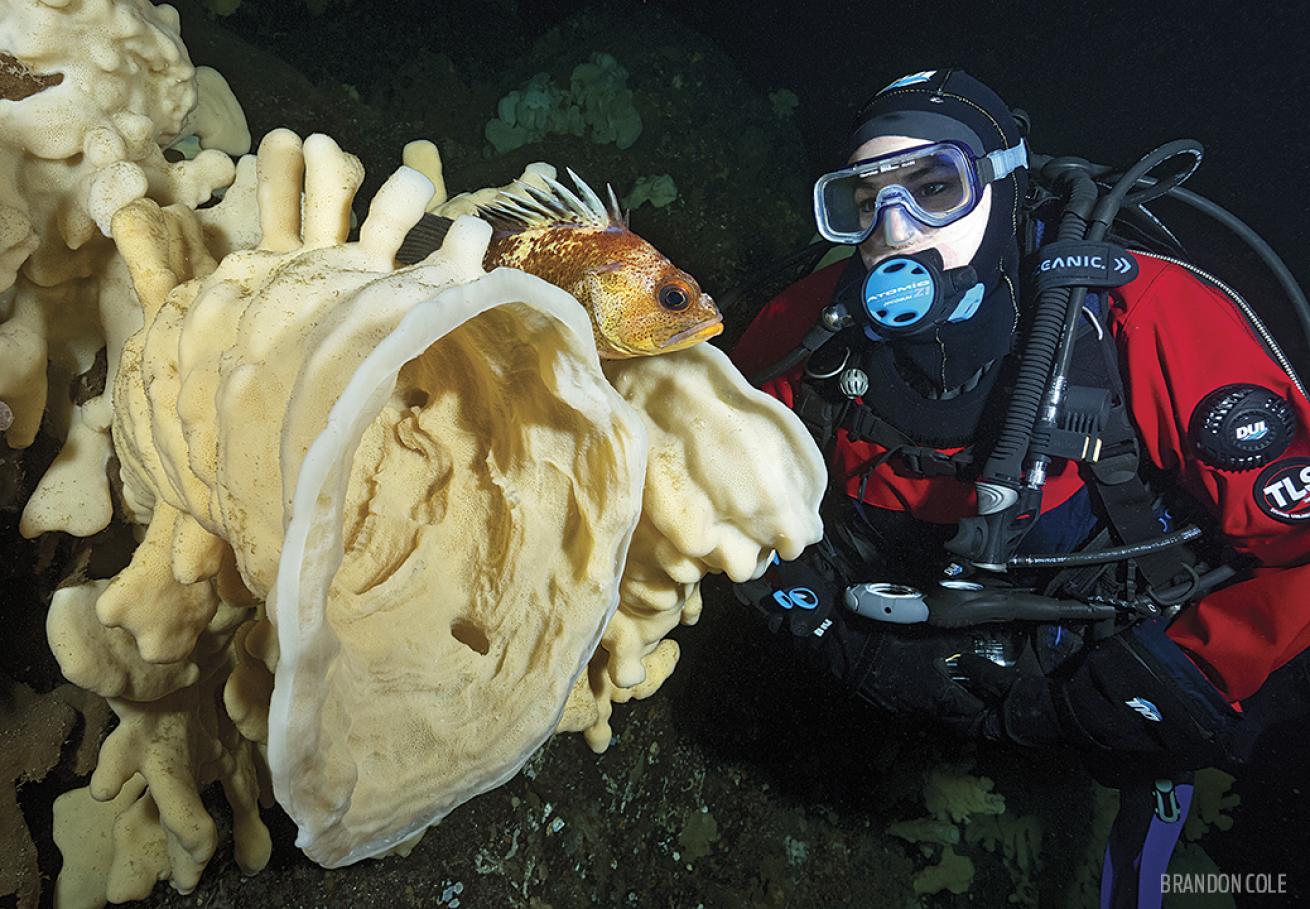
Brandon ColeDiving in British Columbia reveals beautiful cloud sponges and other marine critters.
And so begins our swim through a kaleidoscope. It’s a living, tentacled mosaic of thousands of anemones in red, white, pink, yellow and green, stretching left and right, up and down. Sponges, urchins and sea stars compete for real estate. Life is stacked upon life, a common theme at BC’s best dive sites. I see kelp greenlings and rockfish nonchalantly dancing about in the water column — it will be a different story in half an hour when they have to hunker down like sponges once the maelstrom returns. We spy gobies and sculpins, nudibranchs and crabs, and a magnificent red Irish lord with bulging eyes speckled like a starlit sky. Twenty-five minutes drift by peacefully before someone grabs my fins and turns me around. A bit perturbed that my wife would play such a prank, I look back. But she’s beside me. An invisible, irresistible force begins pushing on my forehead, driving me back. Melissa makes an elaborate signal, two hands circling each other, spinning wildly, and then motions as if she’s sweeping plankton through the water. Impressive, but huh?
I realize I’m kicking now and just barely holding position along the wall. A kelp greenling zings past me to wedge itself snugly into a rock crevice packed with sponges and purple sea stars, their five arms gripping tight. The current has come calling. Our time is up.
Back on board, Helyar’s grin matches ours. “And how was it?” Melissa’s answer says it all: “Can we do that again?”
I blurt out, “And Powerlines too?”
“Sounds like a plan for tomorrow,” Helyar says. “Forecast is even calling for sun.”
Sun on the Sunshine Coast? Maybe, but I look forward to leaving the light far, far behind, deep beneath the sea.
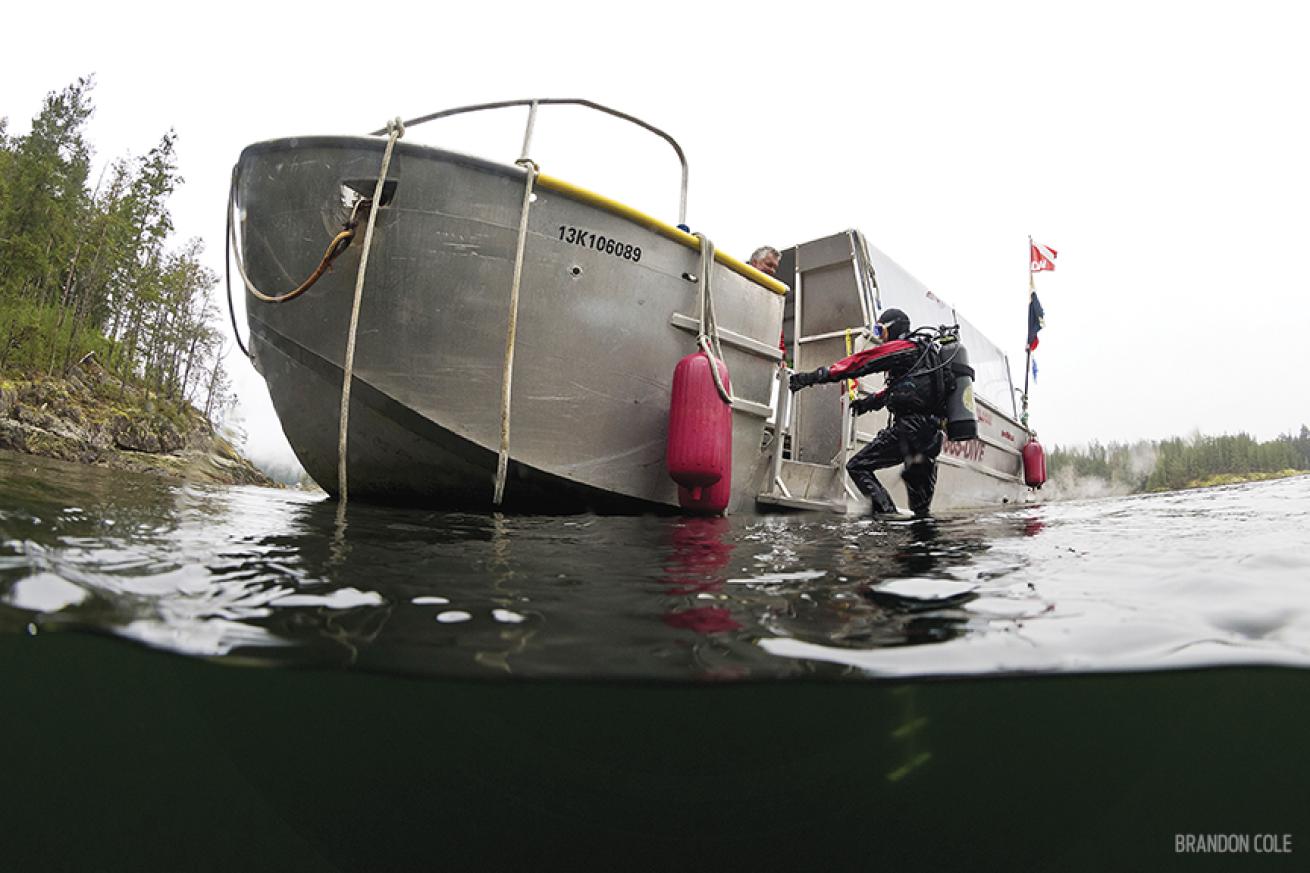
Brandon ColeA dvier returns to Porpoise Bay Charters' purpose-built Devilfish dive boat.
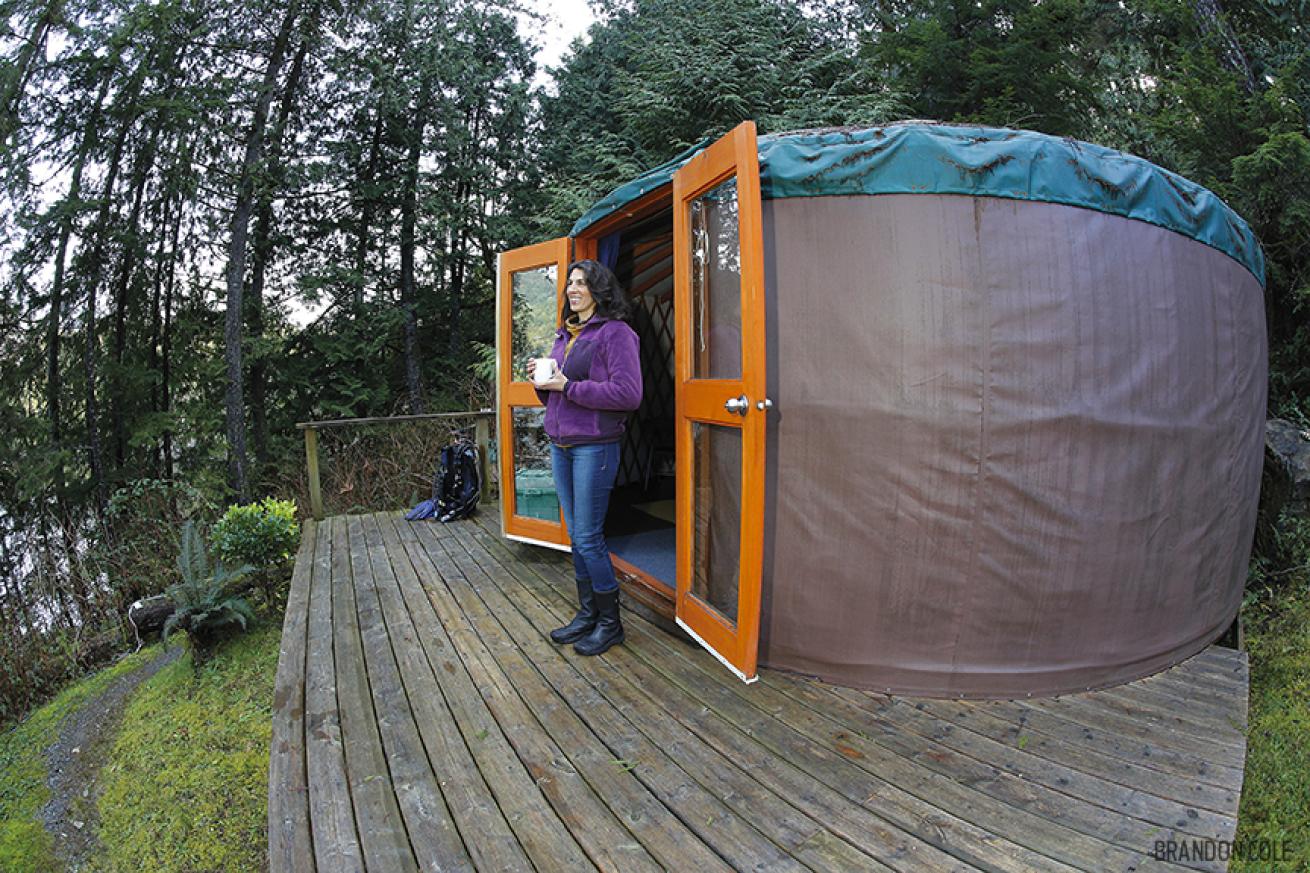
Brandon ColeStrong Water Retreat, on the Sechelt Peninsula, offers cozy yurts surrounded by rainforest.
WHAT IT TAKES
Part of being an advanced diver is being able to avoid damaging marine life. The fragile, delicate nature of many of the creatures found in this area makes operators hesitant to take careless divers to some of these sites — good buoyancy and spatial awareness are key. There’s plenty of current and depth in these inlets; the author cannot stress strongly enough the wisdom in diving with those who know these skookum waters. (Though this article focuses on advanced sites, the region also has many wonderful sites for novices and intermediates.)
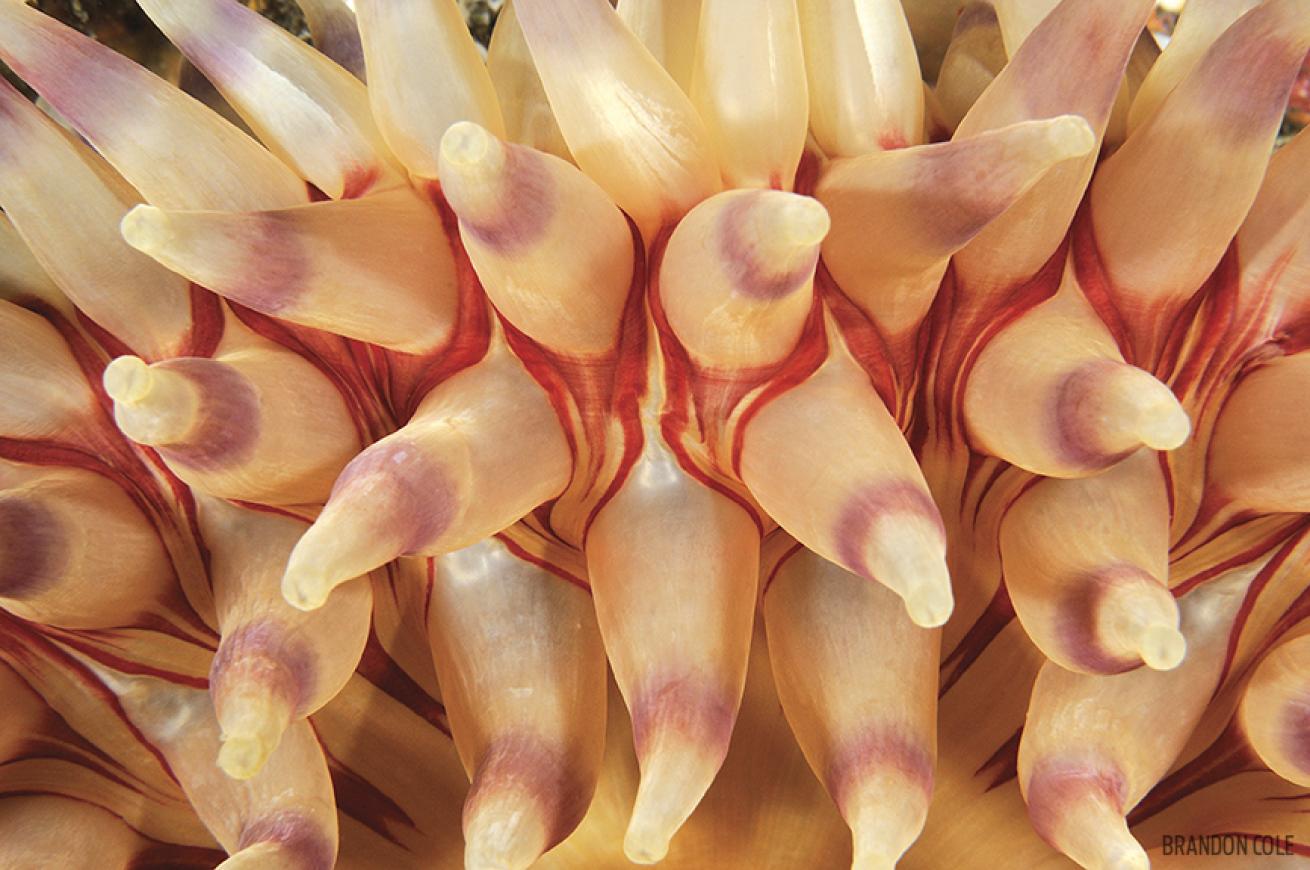
Brandon ColePainted anemones await underwater in British Columbia.
NEED TO KNOW
When to Go British Columbia’s Sunshine Coast offers year-round diving. In general, fall and winter months have the best visibility (50 to 150 feet). Plankton blooms (more common in spring and summer) can reduce visibility, but it’s often still clear below a green surface layer. Topside weather runs the full gamut from cool and rainy to warm and sunny.
Dive Conditions The fjords are well-protected from open-ocean storms and swells. Water temperatures hover around 45 degrees at depth. Drysuits are a must, especially for wintertime multiday diving trips and the long bottom times often realized in technical diving.
Operator Porpoise Bay Charters (porpoisebaycharters.com) has unmatched expertise in these waters. It caters to divers of all skill levels, rec and tec, and is well-equipped to facilitate advanced diving. Cozy waterfront accommodations and savory home-cooked meals at Strong Water Retreat will satisfy all your needs above the waterline.
Price Tag Complete packages (diving, accommodations and meals) cost $250 Canadian per day.
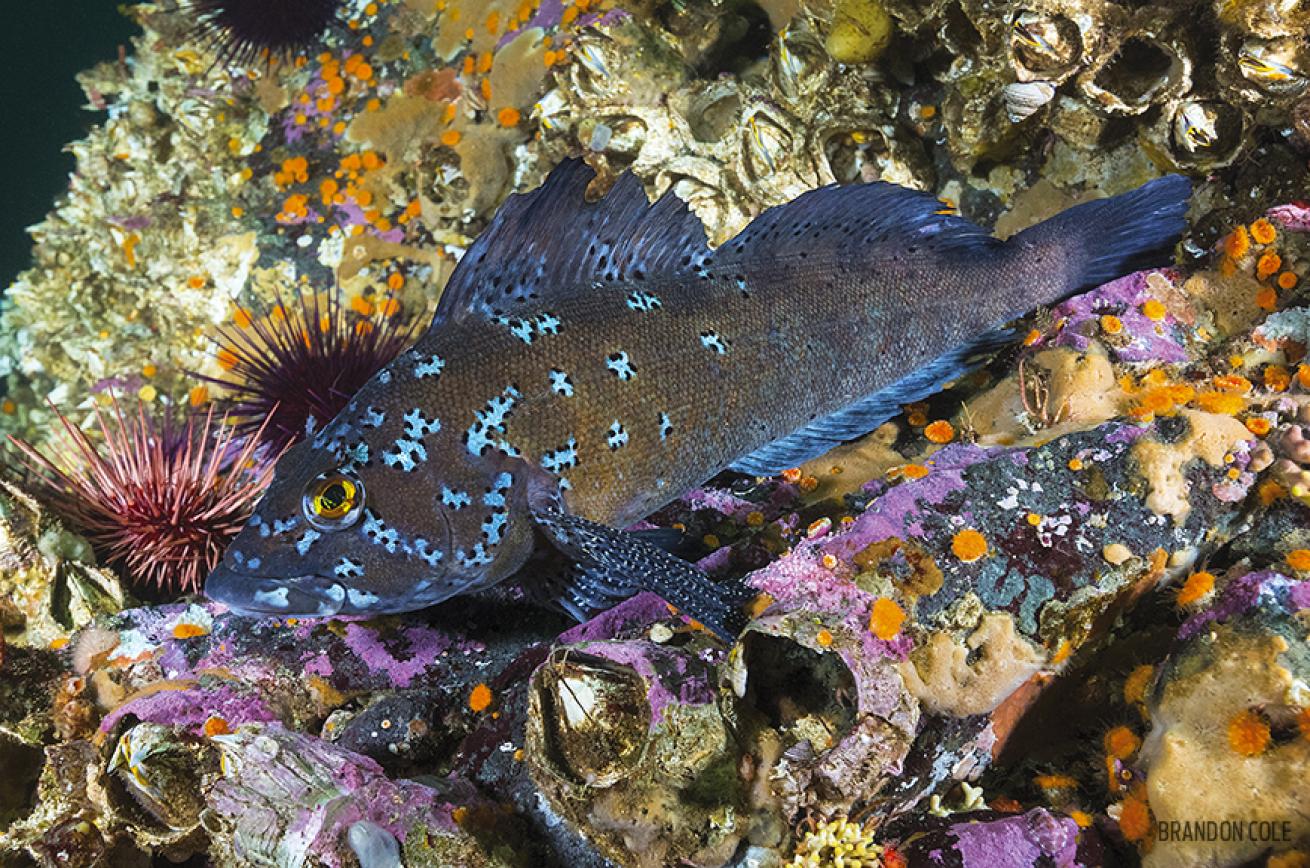
Brandon ColeA male kelp greenling underwater.
FOUR TIPS FOR SHOOTING THE FJORDS
1 Be wary of the unique, rare and very fragile marine life at sites like Powerlines. Cloud sponges and gorgonians are easily killed by careless kicks, grasping hands, flopping gauges and flailing gear. Respect and protect to ensure these deepwater denizens will be there for the next shooter.
2 Balance your rig with foam floats or buoyant strobe arms. At sites subject to current, you’ll appreciate a neutrally balanced rig you can shoot with one hand — your other might be needed to hold onto bare rock or dead barnacles to keep you in position.
3 On the Chaudiere, keep your shot list simple and do your homework. Disorientation and frustration can snowball into trouble. Study a drawing of the ship. Take a slate with you on which you’ve sketched the wreck, your intended path, photo targets, and depths and locations of the fixed buoy lines.
4 Know your photo gear well. Practice on easier dives (or in a dark closet while wearing your gloves) so knowing which buttons to push becomes second nature. There’s no time to waste fiddling around when the slack-tide window is closing fast.
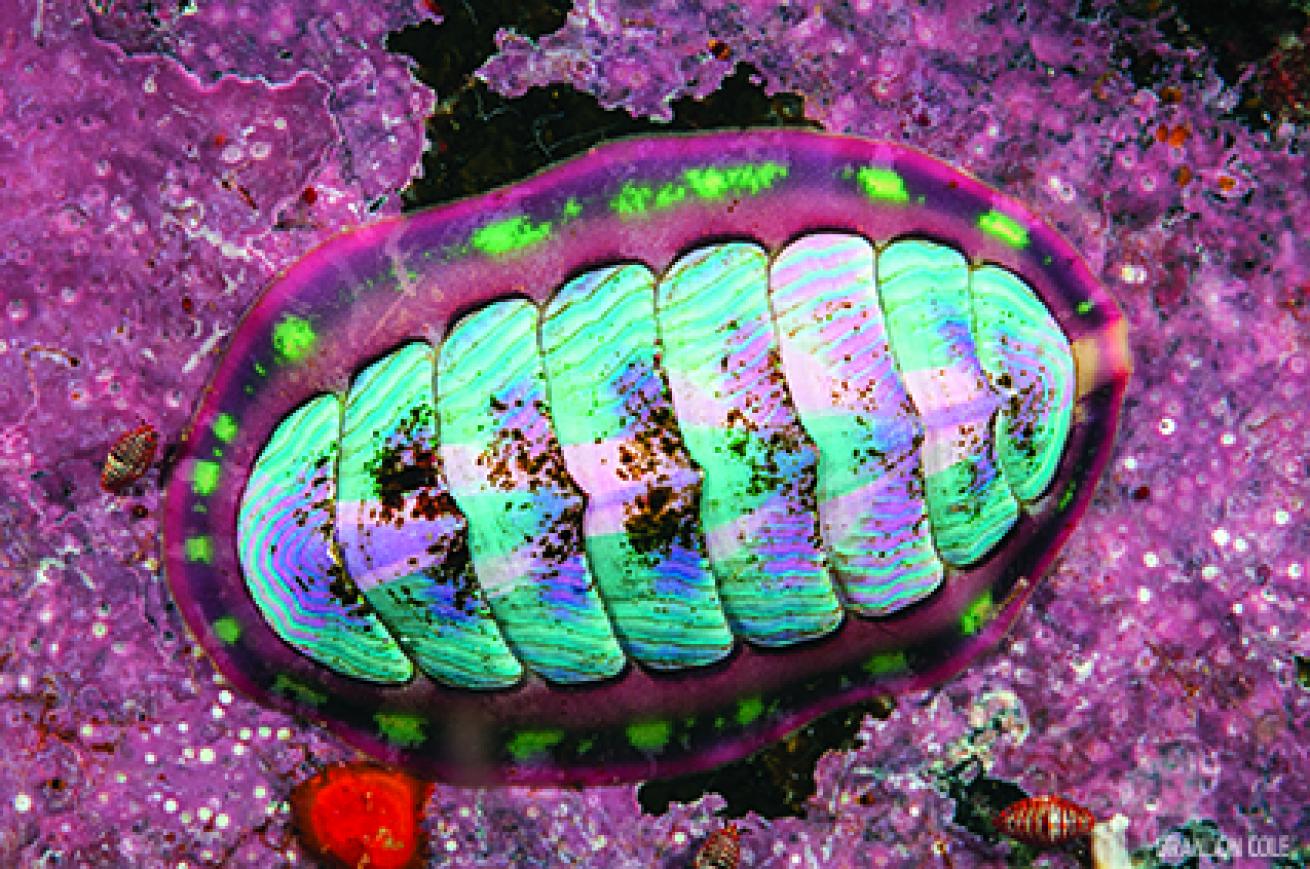
Brandon ColeThe blue-line Chiton is a mollusk whose shell is modified into eight articulating plates which protect its soft underside.

